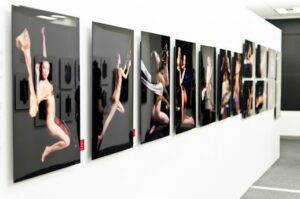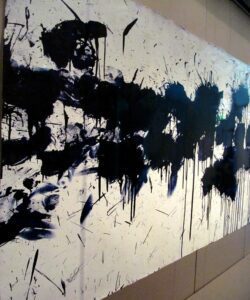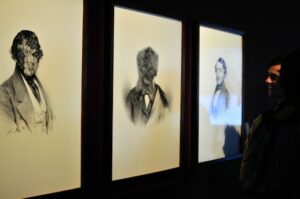Gutai art shatters conventional boundaries, inviting us into a realm where creativity knows no limits.
It’s a movement that dared to ask, “What can art become?
” when post-war Japan sought new expressions.
We’ll jump into the electrifying world of Gutai, exploring how its radical approach to materials, performance, and space revolutionized the art scene.
Get ready to discover the legacy that continues to inspire artists around the globe.
The Origins Of Gutai Art
The genesis of Gutai Art traces back to the aftermath of World War II in Japan.
A cultural phenomenon born amidst the ruins, it became a banner for freedom and innovation.
Spearheaded by Yoshihara Jiro in 1954, Gutai was a bold statement against the artistic traditions of the time.
Yoshihara’s vision inspired a collective of like-minded artists hungry for expressive liberation.
Together, they formed the Gutai art association, a cohesive group yet so diverse in their artistic expressions.
They were united by a desire to transcend the conventional and embody the very meaning of Gutai – “concreteness”.
The early works of Gutai members were a demonstration of art without limits:
- Experiments with non-traditional materials such as mud, paper, and light – Performative art pieces blurring the lines between artist, artwork, and audience – Abstract paintings that engaged physically, splashing and smashing paint with a visceral presence.
Each piece was a rebellion, emboldening individuals to interact with their art on a personal yet universal level.
With its foundations firmly laid, Gutai was rapidly setting the stage for an international dialogue on the nature of art and creativity.
Exploring The Gutai Manifesto
The Gutai Manifesto, penned by Yoshihara Jiro in 1956, served as a battle cry for Gutai artists.
It emphasized the significance of pursuing originality and called upon artists to push beyond the boundaries of existing art forms.
The manifesto demanded a challenge to the abstract expressionism of the time, advocating for an art that was not only novel but that could only be created in the present moment.
Gutai’s principles included –
- Innovation above all else, valuing newness in a piece’s spirit and method.
- The importance of material and performativity in art, urging for a transformation in the material through spiritual freedom.
- A rejection of art that imitated or replicated something else, whether that be an object, an image, or an idea.
The integration of performance, sculpture, painting, and interactive installation was fundamental to Gutai members.
They would often work with unconventional materials like light bulbs, motors, and even smoke to produce works such as Electric Dress by Tanaka Atsuko and Work (Water) by Tsuruko Yamazaki.
These pieces demonstrated the intersection of art and technology, which is a realm we in filmmaking continuously explore and are inspired by.
Gutai’s influence on contemporary art is incontrovertible.
Artists and filmmakers draw on Gutai’s innovative spirit and its focus on interactivity.
The way these artists broke from tradition mirrors the continual evolution in filmmaking, pushing the envelope with digital effects and immersive experiences.
What Gutai taught us was that creativity knows no bounds, and it’s this ethos that drives us to constantly seek fresh perspectives and challenge the status quo in our own storytelling endeavors.
Gutai’s Radical Approach To Materials
Gutai artists were renowned for their unconventional use of materials.
They often chose substances that were fleeting or perishable, ushering in a new level of temporality in art.
Works like Work (Water) by Shimamoto Shozo stand as testaments to the movement’s innovative use of the ephemeral.
The group’s experimentation went beyond just materials to include the process of art-making.
Their performances often involved destroying or altering the materials in a way that defied traditional artistic practices.
Kazuo Shiraga’s Challenging Mud, where the artist wrestled with a mix of cement and mud, exemplifies this approach.
Gutai stood at the forefront of art as a sensory experience.
The materials they used were not just visual but tactile:
- Textures that varied from smooth to rough,
- Substances responsive to touch or movement,
- Integration of sound, where the material itself could resonate or amplify.
This multisensory approach sought to engage the audience actively and was critical in blurring the lines between artwork, creator, and viewer.
Unlike traditional art confined to galleries, Gutai’s creations often required the presence and sometimes participation of an audience to complete the experience.
This interactive element has influenced countless performance artists and filmmakers who emphasize audience engagement in their works.
Their approach also extended to the outdoor spaces, pulling art out of the restricted gallery environment.
In Red Record, Tanaka Atsuko used an actual record player as her canvas, assaulting it with paint, just one example of Gutai’s boundary-pushing forays into combining technology with art.

These bold actions catalyzed a dialogue about the role of art in the modern world and its interaction with technology – a conversation that continues with vigor in the digital age.
Gutai And The Art Of Performance
Gutai artists redefined the concept of performance art through their bold expressions and interactive installations.
They challenged spectators to reconsider their role – not just as observers but as participants in the creation of the art itself.
At the heart of Gutai performance art was the desire to break away from static representations and to embody the fluidity of life.
The interactive nature of Gutai performances meant that each exhibition was a unique encounter, as unpredictable and dynamic as the artists themselves.
In their performances, Gutai artists often used their bodies as a medium, embracing physicality and spontaneity.
Saburo Murakami’s Passing Through involved him forcibly bursting through a series of paper screens, engaging the audience with the sounds and movements that emanated from the act of destruction.
Technological innovations were seamlessly integrated into their performance art, creating sensory experiences that were ahead of their time.
This fusion of technology and performance anticipated many contemporary multimedia practices and remains influential.
Gutai performances often contained elements of:

- Shock and surprise,
- Audience participation,
- Non-traditional materials – Technological incorporation.
Through these methods, Gutai artists conveyed a powerful message about the human condition and the potential of art to express the intangible.
With each performance, new interpretations and experiences emerged, highlighting the transient and mutable nature of their artistic philosophy.
Gutai’s Influence On Space And Environment
Gutai Art fundamentally shifted our perception of space and the artistic environment.
By breaking free from the confines of traditional canvas and sculpture, Gutai artists prompted us to reconsider the interaction between art, space, and viewer.
They transformed any locale into a living canvas, whether it was the earth beneath their feet or the air swirling around.
This transformation of space did not merely alter physical environments but also reshaped the conceptual atmosphere of artistic creation.
Spaces became dynamic – reacting and engaging with the audience, resulting in an immersive, participatory experience.
Artworks such as Mizu by Saburo Murakami demonstrated that the environment itself could become a fluid part of the artistic expression, redefining the boundaries of where art begins and ends.
Our understanding of environmental influence is enriched by the innovative use of unconventional materials in Gutai performances.
Elements like water, light, and sound were not just tools but integral partners in creating art that resonated with the senses and intellect alike.
The incorporation of technology expanded the art form into new domains, making Gutai a precursor to installation art and virtual experiences.
- Gutai art transformed conventional venues like galleries and museums into interactive spaces,
- Outdoor environments were often chosen for their elemental influence and unpredictability.
These changes in spatial dynamics have had a lasting impact on contemporary art forms, notably within the realms of installation art and new media.
Gutai showed us that the setting in which art is presented is as vital as the artwork itself.
It’s a legacy that continues to inspire artists today, pushing them to explore the untapped potential of their surroundings in their creative endeavors.
Gutai’s Enduring Legacy
Gutai Art left an indelible mark on the world of contemporary art.

The collective’s groundbreaking approaches reshaped how we perceive art, expanding its boundaries beyond the canvas and gallery walls.
They dismantled traditional hierarchies within art forms and paved the way for multidisciplinary practices that are commonplace today.
We see Gutai’s influence in the seamless fusion of art and technology where artists continue to experiment with digital media, creating interactive installations that would astound even the most innovative Gutai members.
These pieces often challenge our sensory perceptions and urge us to engage with the environment around us in novel ways, echoing the Gutai spirit.
The principles of Gutai resonate strongly in current trends within the art community:
- Immersive experiences – art installations that engage multiple senses,
- Performance art – that prioritizes the process over the final product,
- Use of unconventional materials – to redefine the meaning of ‘artistic medium’.
In film and video art, Gutai’s legacy is unmistakable.
Our creative work is imbued with the essence of their innovation, particularly when we transform public spaces into dynamic stages for storytelling.
In these instances, viewers become participants, actively shaping the narrative and outcome of the artwork.
It’s not just art spaces that have been influenced by Gutai; its ethos permeates various creative industries.
Whether it’s through the non-conformist spirit of Indie Filmmaking or the adoption of interactive technologies in video production, Gutai’s pioneering approach to creation and presentation has left its mark.
By embracing this legacy, we continuously explore the untapped potential in our environments.
We challenge our audience to rethink what art can be, mirroring Gutai’s commitment to innovation and sensory engagement.
With each new project, we pay homage to the boldness of Gutai artists who reimagined what art could achieve.
What Is Gutai Art – Wrap Up
We’ve seen how Gutai Art has left an indelible mark on the art world, pushing boundaries and inspiring innovation.
Its spirit lives on, encouraging us to see beyond the conventional and experience art in dynamic, interactive ways.
As we continue to witness the evolution of artistic expression, Gutai’s influence remains a beacon for creativity, urging us to embrace the unexpected and celebrate the power of art in its myriad forms.
Let’s carry forward this legacy of experimentation and engagement, allowing Gutai’s revolutionary ideas to guide us toward new artistic horizons.
Frequently Asked Questions
What Is The Gutai Art Movement?
The Gutai Art Movement was a revolutionary post-war movement in Japan that sought to innovate the artistic experience by utilizing unusual materials and methods, engaging the audience with participatory art, and transforming environments into dynamic canvases.
How Did Gutai Artists Redefine Traditional Art?
Gutai artists redefined traditional art by rejecting passive viewership, involving the audience in the creation process, and employing unconventional materials and techniques to create immersive, interactive experiences.
What Impact Did The Gutai Movement Have On Contemporary Art?
Gutai’s influence can be seen in contemporary art genres such as installation art, new media, and video art.
The movement’s principles continue to inspire modern artists to push boundaries and engage viewers on multisensory levels.
Can You Find Gutai Principles In Other Creative Industries?
Yes, Gutai’s non-conformist and interactive ethos has permeated various creative industries, encouraging a spirit of experimentation and the use of interactive technologies to reshape the audience’s experience.
How Does Gutai’s Legacy Inspire Today’s Artists?
Gutai’s legacy inspires artists to continuously explore their environments in novel ways, using creativity to provoke thought and redefine what is possible in art, encouraging an ever-evolving dialogue between the creator, the viewer, and the medium.


